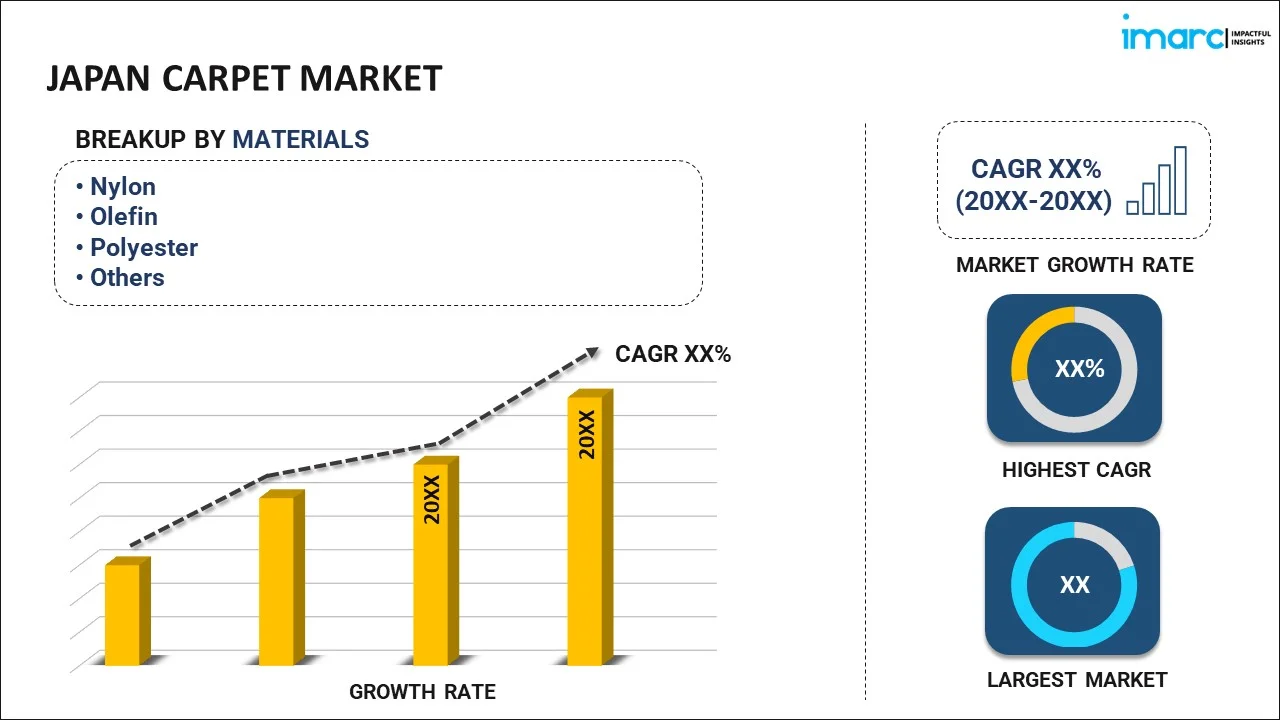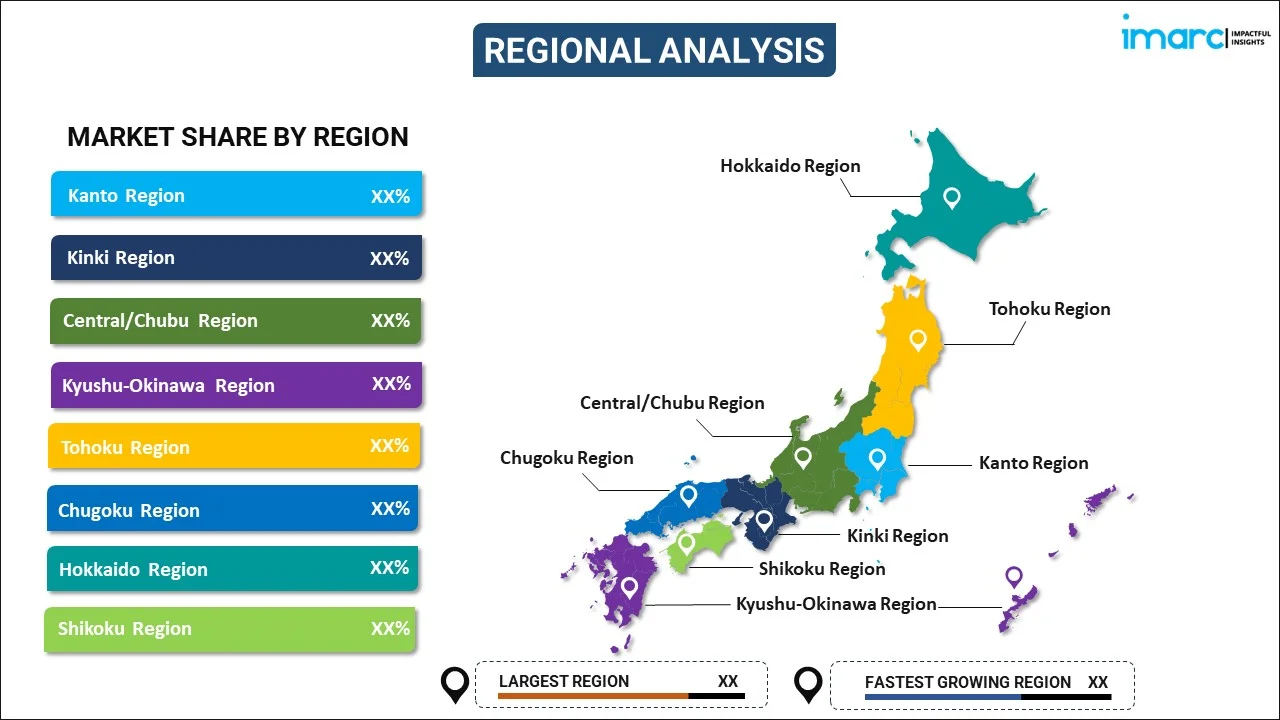
Japan Carpet Market Report by Material (Nylon, Olefin, Polyester, and Others), Price Point (Economy, Luxury), Sales Channel (Supermarkets and Hypermarkets, Specialty Stores, Online Stores), End User (Residential, Commercial), and Region 2025-2033
Market Overview:
The Japan carpet market size reached USD 3,844 Million in 2024. Looking forward, IMARC Group expects the market to reach USD 5,578 Million by 2033, exhibiting a growth rate (CAGR) of 4.2% during 2025-2033. The rising demand for home decor solutions, widespread product utilization in commercial setups, growing awareness about environmental sustainability, rapid technological advancements, increasing customization and hygiene concerns and government initiatives represent some of the key factors driving the market.
|
Report Attribute
|
Key Statistics
|
|---|---|
|
Base Year
|
2024 |
|
Forecast Years
|
2025-2033
|
|
Historical Years
|
2019-2024
|
| Market Size in 2024 | USD 3,844 Million |
| Market Forecast in 2033 | USD 5,578 Million |
| Market Growth Rate (2025-2033) | 4.2% |
Carpet is a widely used flooring material that adds comfort and aesthetic appeal to indoor spaces. It is a textile floor covering made from various materials, such as wool, nylon, polyester, or polypropylene. Carpets are available in a range of styles, colors, and patterns, making them suitable for diverse interior design preferences. They act as insulators, that help to maintain indoor temperatures and reduce energy consumption. Carpets offer sound absorption properties, reducing noise levels and creating a more peaceful environment. They are employed in various applications, such as homes, offices, hotels, and retail spaces, where they serve to improve comfort, reduce noise levels, and add a touch of elegance to the décor. The cushioning effect of carpets makes them ideal for spaces frequented by children and elderly individuals, providing added safety and reducing the risk of slip and fall accidents.
Japan Carpet Market Trends:
The rising demand for interior design and home decor solutions that cater to consumers' evolving preferences is one of the major factors contributing to the market growth. Additionally, the increasing utilization of carpets, due to their ability to imbue warmth and character into living spaces, prompting homeowners and businesses to invest in quality carpets, is strengthening the market growth. Moreover, the growing product popularity to create comfortable and cozy environments in commercial spaces, such as offices and hotels, that look appealing and offer comfort underfoot is positively impacting the market growth. In addition to this, the increasing awareness of environmental sustainability as consumers seek eco-friendly options, leading to a surge in the adoption of carpets made from recycled materials and natural fibers, is propelling the market growth. Furthermore, rapid technological advancements in carpet manufacturing processes, such as innovations in weaving techniques, dyeing methods, and pattern creation resulting in diverse carpets with intricate designs and superior durability, are favoring the market growth. Besides this, the growing focus on carpets with enhanced hygiene features, treated with antimicrobial properties, in various sectors, including healthcare, hospitality, and public spaces, is providing a considerable boost to the market growth. In confluence with this, the evolving lifestyle preferences of Japanese consumers resulting in a surge in demand for customized carpets and unique designs reflecting individual tastes and cultural sensibilities are positively impacting the market growth. Apart from this, the increasing government's initiatives to promote sustainable and environmentally friendly practices encouraging manufacturers to employ eco-conscious production techniques are providing remunerative growth opportunities for the market.
Japan Carpet Market Segmentation:
IMARC Group provides an analysis of the key trends in each segment of the Japan carpet market report, along with forecasts at the country level for 2025-2033. Our report has categorized the market based on material, price point, sales channel, and end user.
Material Insights:

- Nylon
- Olefin
- Polyester
- Others
The report has provided a detailed breakup and analysis of the market based on the material. This includes nylon, olefin, polyester, and others.
Price Point Insights:
- Economy
- Luxury
A detailed breakup and analysis of the market based on the price point has also been provided in the report. This includes economy and luxury.
Sales Channel Insights:
- Supermarkets and Hypermarkets
- Specialty Stores
- Online Stores
A detailed breakup and analysis of the market based on the sales channel has also been provided in the report. This includes supermarkets and hypermarkets, specialty stores, and online stores.
End User Insights:
- Residential
- Commercial
A detailed breakup and analysis of the market based on the end user has also been provided in the report. This includes residential and commercial.
Regional Insights:

- Kanto Region
- Kinki Region
- Central/Chubu Region
- Kyushu-Okinawa Region
- Tohoku Region
- Chugoku Region
- Hokkaido Region
- Shikoku Region
The report has also provided a comprehensive analysis of all the major regional markets, which include Kanto Region, Kinki Region, Central/Chubu Region, Kyushu-Okinawa Region, Tohoku Region, Chugoku Region, Hokkaido Region, and Shikoku Region.
Competitive Landscape:
The report has also provided a comprehensive analysis of the competitive landscape in the market. Competitive analysis such as market structure, key player positioning, top winning strategies, competitive dashboard, and company evaluation quadrant has been covered in the report. Also, detailed profiles of all major companies have been provided.
Japan Carpet Market Report Coverage:
| Report Features | Details |
|---|---|
| Base Year of the Analysis | 2024 |
| Historical Period | 2019-2024 |
| Forecast Period | 2025-2033 |
| Units | Million USD |
| Scope of the Report | Exploration of Historical and Forecast Trends, Industry Catalysts and Challenges, Segment-Wise Historical and Predictive Market Assessment:
|
| Materials Covered | Nylon, Olefin, Polyester, Others |
| Price Points Covered | Economy, Luxury |
| Sales Channels Covered | Supermarkets and Hypermarkets, Specialty Stores, Online Stores |
| End Users Covered | Residential, Commercial |
| Regions Covered | Kanto Region, Kinki Region, Central/Chubu Region, Kyushu-Okinawa Region, Tohoku Region, Chugoku Region, Hokkaido Region, Shikoku Region. |
| Customization Scope | 10% Free Customization |
| Post-Sale Analyst Support | 10-12 Weeks |
| Delivery Format | PDF and Excel through Email (We can also provide the editable version of the report in PPT/Word format on special request) |
Key Questions Answered in This Report:
- How has the Japan carpet market performed so far and how will it perform in the coming years?
- What has been the impact of COVID-19 on the Japan carpet market?
- What is the breakup of the Japan carpet market on the basis of material?
- What is the breakup of the Japan carpet market on the basis of price point?
- What is the breakup of the Japan carpet market on the basis of sales channel?
- What is the breakup of the Japan carpet market on the basis of end user?
- What are the various stages in the value chain of the Japan carpet market?
- What are the key driving factors and challenges in the Japan carpet?
- What is the structure of the Japan carpet market and who are the key players?
- What is the degree of competition in the Japan carpet market?
Key Benefits for Stakeholders:
- IMARC’s report offers a comprehensive quantitative analysis of various market segments, historical and current market trends, market forecasts, and dynamics of the Japan carpet market from 2019-2033.
- The research study provides the latest information on the market drivers, challenges, and opportunities in the Japan carpet market.
- Porter's five forces analysis assist stakeholders in assessing the impact of new entrants, competitive rivalry, supplier power, buyer power, and the threat of substitution. It helps stakeholders to analyze the level of competition within the Japan carpet industry and its attractiveness.
- Competitive landscape allows stakeholders to understand their competitive environment and provides an insight into the current positions of key players in the market.
Need more help?
- Speak to our experienced analysts for insights on the current market scenarios.
- Include additional segments and countries to customize the report as per your requirement.
- Gain an unparalleled competitive advantage in your domain by understanding how to utilize the report and positively impacting your operations and revenue.
- For further assistance, please connect with our analysts.
 Inquire Before Buying
Inquire Before Buying
 Speak to an Analyst
Speak to an Analyst
 Request Brochure
Request Brochure
 Request Customization
Request Customization




.webp)




.webp)












